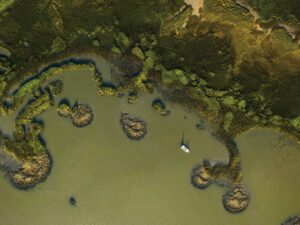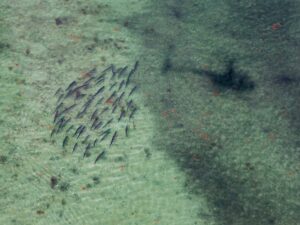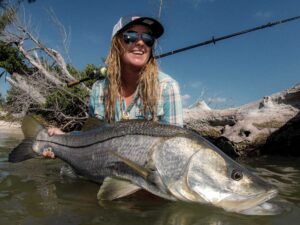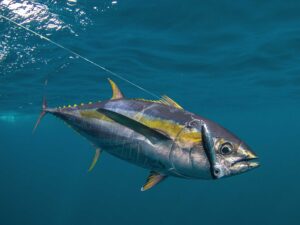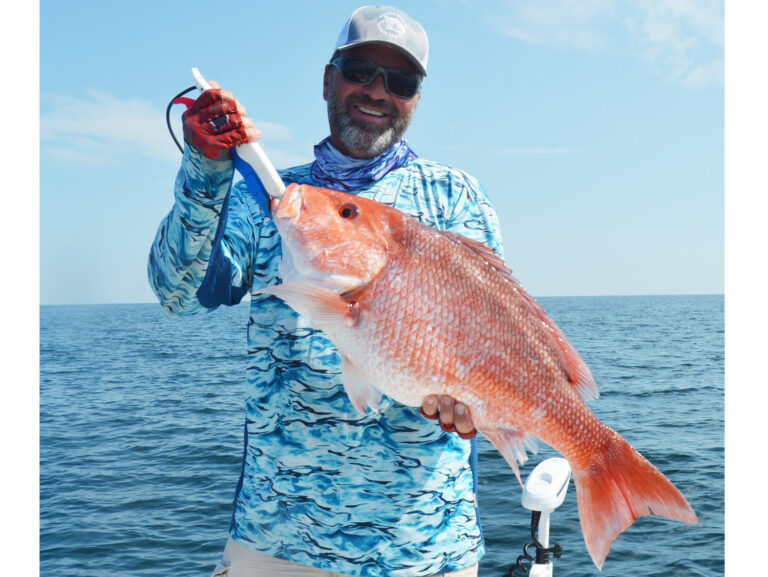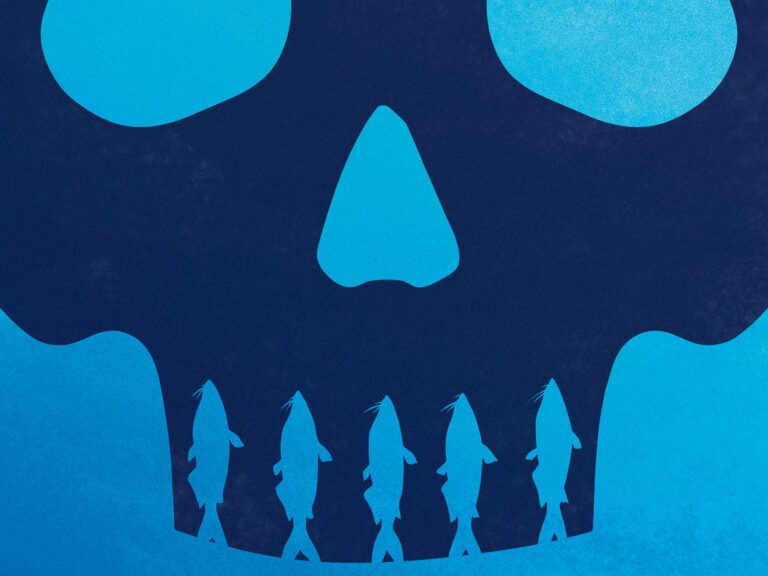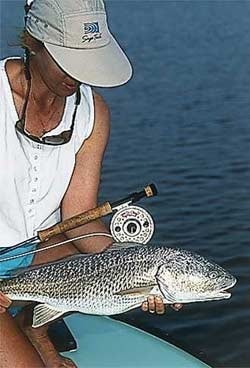
Beginning in the 1970s, an annual late-May pilgrimage took place that gathered many world-record seekers in one small, remote, laid-back fishing village on Florida’s west coast. The greatest fly anglers of the era arrived to pursue the fabled 200-pound tarpon on fly, or at least to take a crack at the current record. Their destination: Homosassa (pronounced home-uh-SASS-uh), about 60 miles north of Tampa.
At any given moment, the shadow of Stu Apte, Billy Pate, Al Pflueger or other luminaries of the fishing world might darken the dock at MacRae’s Bait House on the Homosassa River. Dozens of locals would gather as well to witness the many weigh-ins that rewrote the IGFA record books over the years.
Although recently the west coast of Africa lays claim to the world’s largest silver kings, many great anglers – usually fly fishers – still head to Homosassa, where migrating tarpon swim along the sandy, shallow coastline and offer excellent sight-casting opportunities. But another story has emerged out of Homosassa in the past couple of years in addition to tarpon: great redfish and sea trout fishing.
The resurgence of many inshore species since Florida’s gill-net ban that went into effect several years ago has especially benefited Homosassa due its mixture of oyster bars, grass flats, sand and mud bottom. It’s now common to see skiffs scouring the shallows for reds, trout, bluefish, grouper, cobia and other species while still keeping an eye out for ol’ Mr. Poon.
Bay Battlegrounds
Indeed, it was the prospect of furious light-tackle action with reds and trout that delivered me to the dock at MacRae’s to step aboard the Flats Fisher, Capt. Mike Locklear’s 18-foot Pro-Line skiff. Two young locals joined me: Amanda Handshoe and David Griffin, who’ve been fishing the area since the age of five.
While we waited for Locklear to arrive, I recalled being in Homosassa years before with Stu Apte. We spent a week pursuing tarpon on the long rod, during which time Apte released several 100-plus-pound poons and pulled the hook on a potential 12-pound-tippet record. The exciting action, combined with the beauty and history of Homosassa, felt very special to me then, and I was thrilled to be in this hallowed place again.
Locklear, who’s been a tarpon fly-fishing guide out of Homosassa for 14 years, whisked us along the twisting, sleepy Homosassa River – a memorable experience in itself. Sporadically lined with rustic river homes and oaks laden with spanish moss, the Homosassa River flows smoothly for 5 miles from MacRae’s until spilling out to meet the Gulf of Mexico.
“We’ll try Homosassa Bay first,” says Locklear. “It’s 3 to 4 feet deep with grass patches, and trout love to hide in the grass to ambush food.” The bay’s about 2 1/2 miles north and south of the mouth and 3 miles or so wide. We set up a drift and Locklear suggested we cast down-current. I used a noisy top-water plug while Handshoe and Griffin cast tandem jigs. Right off the bat, Handshoe nailed a nice trout. Griffin scored next, and I finally joined the fray a little later, with all of us enjoying plenty of rod-bending fun.
“I try an area for 20 minutes or so, and if fish aren’t hitting I move a short distance and try again,” Locklear says. “When drifting for trout and hooking up a double, I sometimes toss out a marker and come back by making a circle around the area so as not to disturb the school near the marker – sometimes you can limit out just working the marker,” he says.
Much care is needed by novices navigating the bay. “Most of the rocky areas are marked with stakes, but not all of them,” says Locklear. “Also, you can hit shallow water really quickly – a lot of people run aground or ruin their outdrives.”
After getting our fill of trout action, we ran south past Chassahowitzka Point and entered Chassahowitzka Bay, pronounced “Chaz-Whiskey” or simply called Chaz by locals. Locklear slid into a shallow area and shut down, bumping the bottom slightly. “My custom skeg just got a little more customized,” he joked.
Some areas of Chaz are very shallow, and even experienced boaters can be left high and dry on an outgoing tide. However, the payoff is that this bay usually has less fishing pressure than Homosassa Bay, and it’s also about twice as large. Locklear ran around quite a bit in our search for reds and trout, and we saw only a handful of other boats.
We released trout in the 15- to 20-inch class plus tangled with a few rat reds before I snagged a hefty 22-incher. “Reds tend to run a bit bigger in Homosassa Bay, but Chaz Bay probably accounts for more trout catches year-round,” says Locklear.
Bull Battles
As delightful as it is to catch trout, the main non-tarpon targets around Homosassa most of the year are redfish. Summer months can be excellent when the biggest fish of the year gather and spawn, and large schools can be easy to spot. April also offers top redfishing opportunities amid the comfort and beauty of spring. Redfishing continues to be good through October, and while scarce during cold fronts, reds can be caught pretty much year-round. Reds around Homosassa run up to 14 pounds or more. Florida regulations allow one fish between 18 and 27 inches to be kept.
Target the incoming tide three days before and after the new or full moon phases for optimum redfish opportunities. “They seem to feed better around those times,” Locklear says. However, those who enjoy sight fishing for tailing reds will prefer falling tides, particularly during cooler months because tides are lower then. Fly anglers should cast streamers, bendbacks and epoxy gold spoons; reds will sometimes attack poppers when they’re eating everything else, but weighted flies that sink closer to the bottom draw more hits.
Likely redfish hangouts include shallow, grassy bays or hard-bottom areas near points of islands with good tide flow. Fan-cast thoroughly because you usually must present the offering right in front of a red’s nose for it to strike.
Trout Jousts
Spring and fall bring flurries of trout schools to Homosassa waters. Fish average 15 inches but commonly can be found up to 25, with an occasional 30-incher grabbing the spotlight. If you get into a school of little guys, move to another area – most trout in a school run similar in size.
Locklear searches for grass bottom and limestone outcroppings. “I also like a little wind out of the southwest or west during the first couple of hours of the incoming tide or just before the tide changes,” he says. “Trout also feed ahead of a cold front and during times when the moon is full or new.”
We released 23 trout – 14 of them keeper size – and Handshoe laid claim to the biggest-trout honor by day’s end with a 26-incher estimated to weigh close to 4 pounds. Homosassa’s in the northwest region of Florida’s three trout regions, which allows a 15- to 24-inch slot limit (one of which may exceed 24 inches), a bag limit of seven trout and a February closed season.
“A normal day’s catch is about 20 trout, but some days can be great, with 100 or so,” Locklear says. “We’re still not quite back to the heyday of trout fishing in the 1950s and ’60s, but it’s improving a lot each year. Heck, five years ago you couldn’t even target trout – you’d only catch ’em incidentally.”
Our day treated us to more than redfish and trout action. Locklear spotted one of the deep holes that punctuate the bays and quietly poled near it. We tossed our offerings past the hole and worked them into and over it, and suddenly a triple-header on gag grouper caused a gleeful eruption on the boat. We also caught several hard-fighting bluefish that were cruising around.
Homosassa still thrills the throngs of tarpon anglers around the world, and rightly so. But the name of the game now includes lots of fun and action with several popular game fish – especially redfish and trout – and that’s reason enough to head to Homosassa for a mixed-bag outing in one of Florida’s most beautiful settings.

